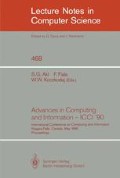Abstract
Certain real life binary relations are symmetric (map point connections, “iff” mathematical statements, multiprocessor links). Such relations can be represented by symmetric 0–1 matrices. Algorithms which take advantage of the symmetry when acting on such matrices, are more efficient than algorithms that are “good for all cases” by assuming a generic (non-symmetric) matrix. No algorithm, to our knowledge, focusing on symmetric matrices has been designed up to date for the computation of the transitive closure. In this paper, four algorithms - G, Symmetric, 0-1-G, 1-Symmetric - are given for computing the transitive closure of a symmetric binary relation which is represented by a 0–1 matrix. Algorithms G and 0-1-G pose no restriction on the type of the input matrix, while algorithms Symmetric and 1-Symmetric require it to be symmetric. These four algorithms are compared to Warren's algorithm in terms of the number of page faults incurred. Experimental results indicate that the new algorithms (with the exception of algorithm G) are about 2 times faster than Warren's algorithm for sparse matrices, 10 to 100 times faster for dense matrices, and about 1.4 times faster for medium dense matrices.
Preview
Unable to display preview. Download preview PDF.
References
Arlazarov, V. L., Dinic, E. A., Kronrod, M. A., and Faradzev, I. A. “On Economical Construction of the Transitive Closure of an Oriented Graph”, Soviet Math. Doklady 11, 1970, 1209–1210.
Agrawal, R., Borgida A., and Jagadish, H., “Efficient management of transitive relationships in large data and knowledge bases”, ACM SIGMOD 1989, 253–262.
Agrawal, R. and Jagadish, H.V. “Direct Algorithms For Computing the transitive closure Of Database Relations”, Proc. 13-th VLDB, Brighton, England, Sept. 1987.
Baker, J.J. “A note on Multiplying Boolean Matrices”, CACM, 1962, 102.
Bancilhon, F. “Naive Evaluation of Recursively Defined Relations”, On Knowledge Based Management Systems — Integrating Database and AI Systems, M. Brodie and J. Mylopoulos, eds., Springer-Verlag, 1985.
Bancilhon, F. and Ramakrishnan, R. “An Amateur's Introduction to Recursive Query Processing Strategies” ACM SIGMOD 1986, 16–52.
Ioannidis, Y.E.. “On the Computation of the transitive closure of Relational Operators”, Proc. 12-th VLDB, Kyoto, Japan, 1986, 403–411.
Ioannidis, Y.E. and Ramakrishnan, R., “Efficient Transitive Closure of Relational Operators”, Proc. 14-th VLDB, Los Angeles, California, 1988, 382–394.
Jagadish, H.V., Agrawal, R., and Ness, L. “A Study of transitive closure as a Recursion Mechanism”, ACM SIGMOD 1987, 331–344.
Lu, H., “New Strategies for Computing the Transitive Closure of a Database Relation”, Proc. 13-th VLDB, Brighton, England, 1987, 267–247.
Lu, H., Mikkilineni, K., and Richrardson, J.P. “Design and Evaluation of Algorithms to Compute the transitive closure of a Database Relation” Proc. IEEE 3-rd Inter. Conf. Data Engineering, Los Angeles, Feb. 1987, 112–119.
Naughton, J.F., Ramakrishnan, R., Sagiv, Y., and Ullman, J.D., “Efficient evaluation of right-, left-, and multilinear rules”, ACM SIGMOD 1989, 235–242.
Schmitz, L., “An Improved Transitive Closure Algorithm”, Computing 30, 1983, 359–371.
Schnorr, C.P. “An Algorithm for transitive closure with Linear Expected Time”, SIAM J. Computing 7, 1978, 127–133.
Valduriez, P. and Boral, H. “Evaluation of Recursive Queries Using Join Indices” Proc. 1-st Inter. Conf. on Expert Database Systems, Charleston, 1986, 197–208.
Warren, H., Jr. “A Modification of Warshall's Algorithm for the transitive closure of Binary Relations”. CACM 18, 1975, 218–220.
Warshall, S., “A Theorem on Boolean Matrices”, Journal of the ACM 9, 1962, 11–12.
Author information
Authors and Affiliations
Editor information
Rights and permissions
Copyright information
© 1991 Springer-Verlag Berlin Heidelberg
About this paper
Cite this paper
Toptsis, A.A., Yu, C.T., Nelson, P.C. (1991). Computing the transitive closure of symmetric matrices. In: Akl, S.G., Fiala, F., Koczkodaj, W.W. (eds) Advances in Computing and Information — ICCI '90. ICCI 1990. Lecture Notes in Computer Science, vol 468. Springer, Berlin, Heidelberg. https://doi.org/10.1007/3-540-53504-7_74
Download citation
DOI: https://doi.org/10.1007/3-540-53504-7_74
Published:
Publisher Name: Springer, Berlin, Heidelberg
Print ISBN: 978-3-540-53504-1
Online ISBN: 978-3-540-46677-2
eBook Packages: Springer Book Archive

